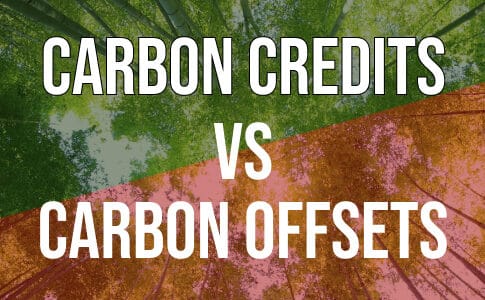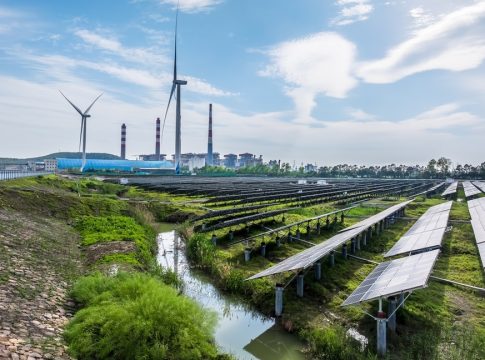Carbon Credits vs. Carbon Offsets
Carbon Credits vs. Carbon Offsets: What’s the Difference?
At their core, both carbon credits and carbon offsets are accounting mechanisms. They provide a way to balance the scales of pollution. The big idea behind credits and offsets is that since CO2 is the same gas anywhere in the world, it doesn’t matter where emissions reduction happen.
For both consumers and companies, it makes financial sense to reduce emissions where it is cheapest and easiest to do so, even if that does not involve their own operations.
Offset and Credit Similarities
At the simplest level, a carbon credit or offset represents a reduction in or removal of greenhouse gas (GHG) emissions that compensates for CO2 emitted somewhere else. The instruments do have two major attributes in common:
One carbon credit or offset equals one tonne of carbon emissions.
Once a carbon credit or offset is purchased and the CO2 is emitted, that credit is “retired” and cannot be sold or used again.
Carbon Offsets and Carbon Credits Defined
While the terms “carbon credits” and “carbon offsets” are often used interchangeably, they refer to two distinct products that serve two different purposes. Before you begin purchasing either, it’s important to understand the difference between the two and which one will help you meet your goals. Here is a broad definition of the terms:
Carbon offset: A removal of GHGs from the atmosphere.
Carbon credit: A reduction in GHGs released into the atmosphere.
To help visualize the difference, imagine a water supply polluted by a nearby chemical plant. A “chemical offset” would mean pulling chemicals out of the water to help purify it. A “chemical credit” would mean paying another chemical company to release fewer chemicals into the water, so the overall level of pollution stays the same. Clear as mud? Great.
A Carbon Offset and Carbon Credit Primer*
Let’s dive a bit deeper into these products one at a time. Creating a carbon offset involves a fancy term we call “carbon sequestration.” Recall how a judge can order a jury to be sequestered—meaning they have to be sealed off from the outside world.
It works the same way with carbon: offsets involves CO2 emissions pulled out of the atmosphere and locked away for a period of time.
There is a growing list of ways to do this, including planting forests, blasting rock into tiny pieces, storing carbon in manufactured devices, capturing methane gas at a landfill, and the holy grail of carbon sequestration: using sophisticated technology to turn CO2 emissions into a usable product.
Carbon offsets are produced by independent companies that pull CO2 emissions from the atmosphere. The offsets are then sold to companies that emit (or have emitted) CO2. In a sense, offset-producing companies are directly funded by those companies that emit GHGs.
Carbon credits, on the other hand, are generally “created” by the government. Governments limit the amount of GHGs organizations can emit by placing a cap on them—a specific number of tons of CO2 the company can emit. Each of those tons are referred to as a carbon credit.
Companies comply with that cap by reducing the emissions produced in their operations through improving energy efficiency or switching to renewable energy sources. An organization that brings its overall emissions below what is required by law can sell the excess credits to businesses that are unable or unwilling to cut their own emissions to become compliant.
There are a few other ways to produce carbon credits. For more detail, see our article on carbon credits.
The Two Carbon Markets
There’s one more important distinction between carbon credits and carbon offsets:
Carbon credits are generally transacted in the carbon compliance market.
Carbon offsets are generally transacted in the voluntary carbon market.
Mandatory schemes limiting the amount of GHG emissions grew in number. And with them, a fragmented carbon compliance market is developing. For example, the EU has an Emissions Trading System (ETS) that enables companies to buy carbon credits from other companies.
California runs its own cap-and-trade program. Nine other states on the eastern seaboard have formed their own cap-and-trade conglomerate, the Regional Greenhouse Gas Initiative.
The voluntary carbon market (think: offsets) is much smaller than the compliance market, but expected to grow much bigger in the coming years. It is open to individuals, companies, and other organizations that want to reduce or eliminate their carbon footprint, but are not necessarily required to by law.
Consumers can purchase offsets for emissions from a specific high-emission activity. An example would be a long flight. Or they can buy offsets on a regular basis to eliminate their ongoing carbon footprint.
Do I Need Carbon Offsets or Carbon Credits?
Now that you know their differences and what they have in common, here’s how carbon credits and carbon offsets work in the grand, global scheme of emissions reduction.
The government is putting heavy caps on GHG emissions, meaning that companies will have to reconfigure operations to reduce emissions as much as possible. Those that cannot be eliminated will have to be accounted for through the purchase of carbon credits. Ambitious organizations, corporations, and people can purchase carbon offsets to nullify previous emissions or to reach net zero.
So which do you need? If you’re a corporation, the answer is likely “both”—but it all depends on your business goals. If you’re a consumer, carbon credits are likely unavailable to you. But you can do your part by purchasing carbon offsets.
Returning to the illustration from earlier, our vital, global goal is to both stop dumping chemicals into the metaphorical water supply, and to purify the existing water supply over time. In other words, we need to both drastically reduce CO2 emissions. And then we work to remove the CO2 currently in the atmosphere if we want to materially reduce pollution.
*Note: See our in-depth articles on carbon credits and carbon offsets for a closer look at how they work.
The post Carbon Credits vs. Carbon Offsets appeared first on Carbon Credits.



